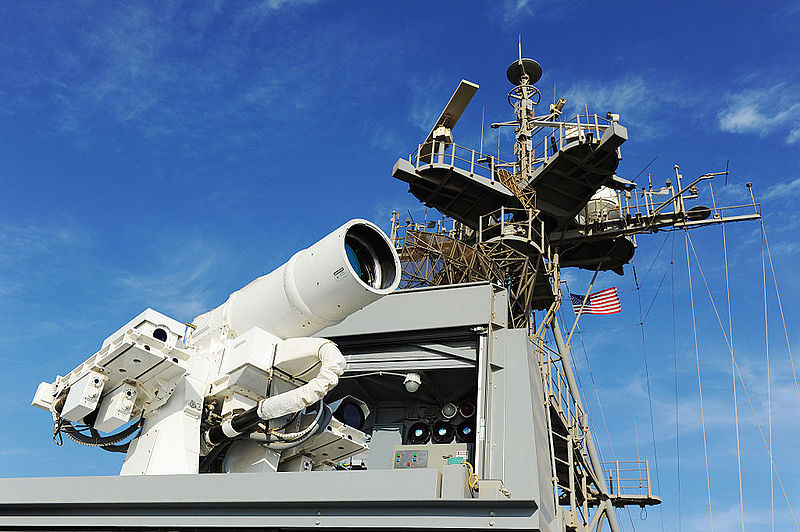Laser weapons have been a pop culture obsession for decades. Comic hero Flash Gordon used a laser gun twenty-six years before lasers were even invented. Mention the Star Wars franchise to anyone and space battles with the distinct sounds of the iconic laser weapons immediately come to mind. But what used to be fiction is now becoming a reality as militaries and weapons manufacturers around the world begin to develop the technology for effective laser weapons.
Laser Weapons Systems (LaWS) have moved to the forefront of weapons technology development in only the past few years. Major corporations, such as Boeing and Lockheed Martin have begun to pour significant resources into LaWS development and the industry. It is estimated that the LaWS technology will increase in worth up to $1.2 billion USD over the next nine years.
LaWS can be both an effective offensive and defensive weapon. By quickly heating its target, a laser can destroy and incapacitate a variety of technologies by piercing armour plating or destroying important electronics systems. A laser weapon could also be used to target enemy artillery shells in midair, detonating them before they reach their target. In a video published by Office of Naval Research, a preliminary laser weapon equipped to the U.S.S. Ponce can be seen detonating ammunition on a moving target and incapacitating a drone. However, there is still significant research that needs to be accomplished before the primary use of LaWS and the amount of damage they can do is fully understood.
https://www.youtube.com/watch?v=D0DbgNju2wE&feature=youtu.be
Footage of the laser weapon equipped to the U.S.S. Ponce. Courtesy of the Office for Naval Research.
State-sponsored research and development plays a large role in propelling this technology forward. The 30KW on the U.S.S. Ponce, an Austin-class amphibious transport dock currently deployed in the Arabian Sea, is the most notable advancement of American LaWS technology. In January of this year, China announced in its official army newspaper that its soldiers were equipped with personal laser weapons. Iran is also reported to be experimenting with laser weapons to target aircraft. The US Navy hopes to develop a 100KW and 150KW laser by 2018, thus substantially increasing capabilities and power of the weapon.
However, several aerospace corporations have begun taking steps towards LaWS development. In late 2015, Lockheed Martin announced it was looking into the idea of equipping F-35s with laser weapons. There has also been talk of equipping AC-130 gunships (Lockheed Martin), B-1 Lancer bombers (North American Rockwell/Boeing) and B-2 Spirit stealth bombers (Northrop Grumman) with LaWS as well.
But how do lasers work? A quick physics refresher: light moves in waves. Regular light, such as the light coming out of your light bulbs at home, has multiple frequencies moving in all directions. However, a laser is different. The light from a laser consists of waves with the same frequency moving in a single direction with a very high intensity. Most importantly, the waves of light in a laser are ‘coherent’ meaning that they line up all together.

Courtesy of the NATO Association of Canada.
Some lasers are more energetic than others. A laser pointer is good example of a low energy laser. The frequency of light waves in red laser beams is quite low and thus the laser has a low energy. In military-grade lasers the frequency of light waves is higher, allowing it to obtain its destructive quality. Contrary to popular culture, high energy lasers are invisible to the human eye, making them an effective weapon.
Right now, laser weapons technology is still in the testing phase and has yet to be used in a combat situation. A question for the international community may be whether or not some LaWS should be considered illegal under international law. Apart from the treaties, conventions, and norms that are part of the general law of war, the only specific governing covenant is the Protocol on Blinding Laser Weapons, which was signed in 1995. Military officials have indicated that using non-lethal laser weapons on civilians is possible development for the technology. Consequently, the statesmen will need to grapple with how to limit LaWS once they become a part of combat in the not so distant future.
Main Photo: Laser weapon aboard the U.S.S. Ponce (2014), by John F. Williams (U.S. Navy) via Wikimedia Commons. Public Domain.
Disclaimer: Any views or opinions expressed in articles are solely those of the authors and do not necessarily represent the views of the NATO Association of Canada.




